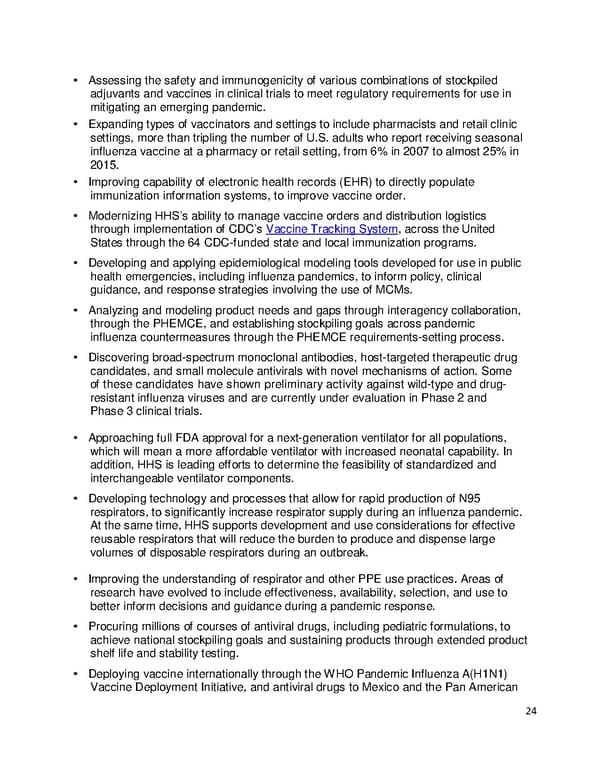• Assessing the safety and immunogenicity of various combinations of stockpiled adjuvants and vaccines in clinical trials to meet regulatory requirements for use in mitigating an emerging pandemic. • Expanding types of vaccinators and settings to include pharmacists and retail clinic settings, more than tripling the number of U.S. adults who report receiving seasonal influenza vaccine at a pharmacy or retail setting, from 6% in 2007 to almost 25% in 2015. • Improving capability of electronic health records (EHR) to directly populate immunization information systems, to improve vaccine order. • Modernizing HHS’s ability to manage vaccine orders and distribution logistics through implementation of CDC’s Vaccine Tracking System, across the United States through the 64 CDC-funded state and local immunization programs. • Developing and applying epidemiological modeling tools developed for use in public health emergencies, including influenza pandemics, to inform policy, clinical guidance, and response strategies involving the use of MCMs. • Analyzing and modeling product needs and gaps through interagency collaboration, through the PHEMCE, and establishing stockpiling goals across pandemic influenza countermeasures through the PHEMCE requirements-setting process. • Discovering broad-spectrum monoclonal antibodies, host-targeted therapeutic drug candidates, and small molecule antivirals with novel mechanisms of action. Some of these candidates have shown preliminary activity against wild-type and drug- resistant influenza viruses and are currently under evaluation in Phase 2 and Phase 3 clinical trials. • Approaching full FDA approval for a next-generation ventilator for all populations, which will mean a more affordable ventilator with increased neonatal capability. In addition, HHS is leading efforts to determine the feasibility of standardized and interchangeable ventilator components. • Developing technology and processes that allow for rapid production of N95 respirators, to significantly increase respirator supply during an influenza pandemic. At the same time, HHS supports development and use considerations for effective reusable respirators that will reduce the burden to produce and dispense large volumes of disposable respirators during an outbreak. • Improving the understanding of respirator and other PPE use practices. Areas of research have evolved to include effectiveness, availability, selection, and use to better inform decisions and guidance during a pandemic response. • Procuring millions of courses of antiviral drugs, including pediatric formulations, to achieve national stockpiling goals and sustaining products through extended product shelf life and stability testing. • Deploying vaccine internationally through the WHO Pandemic Influenza A(H1N1) Vaccine Deployment Initiative, and antiviral drugs to Mexico and the Pan American 24
 Pandemic Influenza Plan Page 23 Page 25
Pandemic Influenza Plan Page 23 Page 25